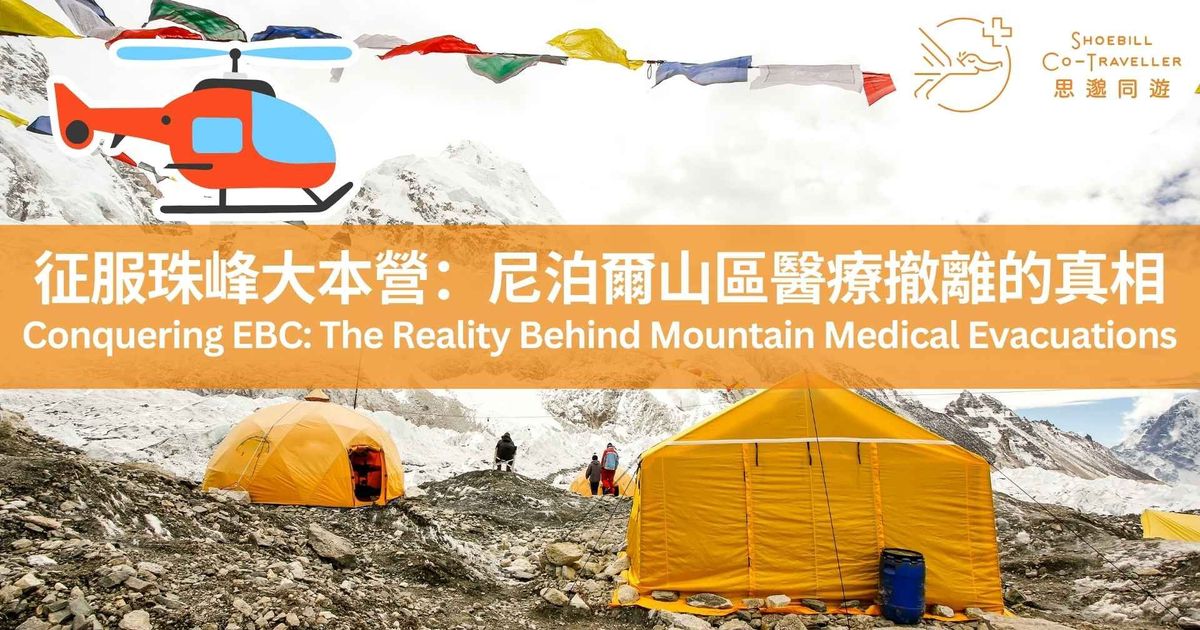
In March 2024, Shoebill Health's 8-person team successfully completed the Everest Base Camp (EBC) trek. We journeyed through the stunning Gokyo Lakes and crossed the Cho La Pass, surrounded by glaciers, deep valleys and towering snow-capped peaks. The scenery was absolutely breathtaking.
But what left the deepest impression wasn’t just the landscape—it was the near-constant sound of helicopters above. Day and night, we saw trekkers being airlifted due to illness or emergencies. For us, city-dwellers from Hong Kong used to immediate medical services, it was a wake-up call: medical evacuation in Nepal’s mountain regions is far from simple.
Hidden Risks of the EBC Trek
Acute Mountain Sickness (AMS)
Whether you’re a foreigner or a local, anyone who ascends quickly to high altitudes is at risk of AMS. Common symptoms include headaches, nausea, shortness of breath and sleep disturbance. In severe cases, it can develop into life-threatening conditions like High-Altitude Pulmonary Edema (HAPE) or High-Altitude Cerebral Edema (HACE). Want to know more? Check out our blog on High-Altitude Travel.
Traveller’s Diarrhea & Hygiene Challenges
Sanitation in mountain lodges is limited. Drinking water needs to be boiled or filtered, and raw or undercooked food should be avoided. When your body is already working hard to adjust to altitude, a sudden gastrointestinal issue can ruin your trip—and severe diarrhea can lead to dehydration, worsening altitude sickness symptoms.
The Reality of Medical Evacuation
Many people assume: “It’s fine, if I get sick, I’ll just call a helicopter to Kathmandu!” Not quite. At the 2024 Asia Pacific Travel Health Conference (APTHC), we spoke with representatives from the Himalayan Rescue Association (HRA). They summarized 4 key challenges of medical evacuation in Nepal:
1. Not All Helicopters Are Medical-Grade
Most helicopters are basic transport choppers without medical equipment or trained staff. Professional medevac helicopters are limited and not always available—especially for amateur trekkers.
2. Unpredictable Weather
Mountain weather changes rapidly. Strong winds, fog or snow can delay or ground helicopters for hours or days. This means patients often have to wait in harsh conditions.
3. Evacuation Doesn’t Always Mean Kathmandu
Most patients are first taken to the nearest medical post. Only the most serious cases are flown to hospitals in Kathmandu.
4. No Insurance = Pay Upfront
Emergency evacuations can cost USD 10,000 or more. Trekkers must present valid travel insurance before flights are arranged. Without it, the helicopter company may refuse service unless a deposit is paid in advance.
How to Reduce Your Risk: 3 Key Tips
1. Prevention Is Better Than Cure
- Book a pre-travel health consultation to assess your fitness for high-altitude trekking.
- Bring essential medications for altitude sickness and diarrhea.
- Learn to recognize early symptoms of AMS.
2. Plan Your Itinerary and Exit Strategy
- Join a licensed and experienced trekking agency with guides trained in first aid and evacuation procedures.
- Plan for a gradual ascent and include rest days.
- Know the locations of medical posts along your route.
- Trek with a group—never go solo.
3. Medevac Is a Last Resort, Not a Guarantee
- Make sure your travel insurance includes high-altitude evacuation.
- Don’t treat helicopters as your “Plan B”. Too many unpredictable factors are involved.
Final Thoughts: Plan Smart, Trek Safe
The Everest Base Camp trek is truly a once-in-a-lifetime experience. But altitude sickness, digestive issues, and unpredictable weather can quickly turn your dream trip into a nightmare. Proper preparation, risk awareness, and knowing how to respond in emergencies are the real keys to enjoying your trek safely.
Book a travel health consultation with Shoebill, we’ll help you prepare the right way with a personalised pre-travel health assessment and practical advice so you can hike with peace of mind.


